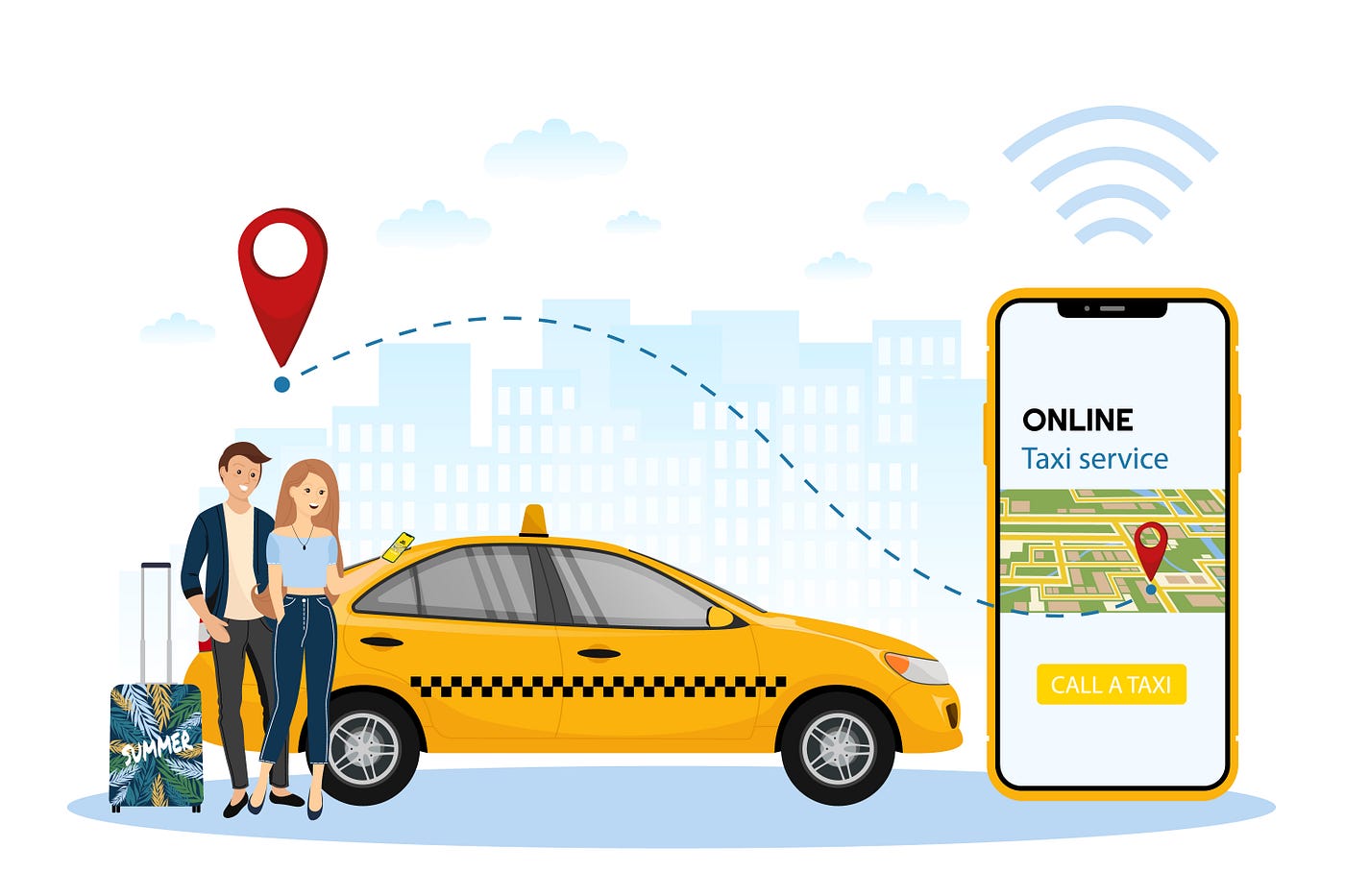The taxi industry has changed significantly over the past decade, mostly due to the introduction and widespread use of ride-hailing applications like Uber, Lyft, and others. These platforms have completely changed the way people commute offering efficiency, affordability, and convenience. However, as technology develops at an unprecedented rate, the future of taxi booking app development businesses is poised for further transformation. This blog will examine the major technological developments that are likely to impact the taxi app industry in the coming years, analyzing how these advancements can shape the future landscape of urban mobility.
1. Artificial Intelligence and Machine Learning
Artificial Intelligence (AI) and Machine Learning (ML) are at the forefront of technological advancements across various industries, and taxi app businesses are no exception. AI and ML have the potential to enhance numerous aspects of the ride-hailing experience:
a. Predictive Analytics: AI can analyze vast amounts of data to predict demand patterns, helping companies deploy their fleets more efficiently. This leads to reduced wait times for passengers and optimized routes for drivers, ultimately improving the overall user experience.
b. Dynamic Pricing: AI algorithms can adjust prices based on real-time supply and demand. This ensures that ride prices remain competitive while also maximizing profits for drivers and the platform.
c. Fraud Detection: Machine learning models can identify and mitigate fraudulent activities, such as fake ride requests and payment fraud, by analyzing patterns and anomalies in user behavior.
d. Personalized Experiences: AI can be used to offer personalized services to users, such as preferred routes, music, or even vehicle types based on their previous rides and preferences.
2. Autonomous Vehicles
Autonomous vehicles (AVs) represent one of the most significant technological advancements that could disrupt the taxi app industry. Self-driving cars promise a future where human drivers are replaced by autonomous systems, offering several potential benefits:
a. Cost Reduction: Eliminating the need for human drivers can significantly reduce operational costs for taxi companies, leading to lower fares for passengers.
b. Safety Improvements: Autonomous vehicles are designed to adhere strictly to traffic rules and have the potential to reduce accidents caused by human error.
c. Increased Accessibility: AVs can provide mobility solutions for individuals who are unable to drive, such as the elderly or disabled.
d. Fleet Efficiency: Autonomous fleets can be managed centrally, optimizing routes and reducing downtime, further improving efficiency.
However, the widespread adoption of AVs faces several challenges, including regulatory hurdles, public acceptance, and the need for substantial advancements in AI and sensor technologies.
3. Internet of Things (IoT)
The Internet of Things (IoT) involves connecting various devices to the Internet, enabling them to collect and exchange data. In the context of taxi app businesses, IoT can play a crucial role in several ways:
a. Vehicle Maintenance: IoT sensors can monitor the health of vehicles in real time, predicting maintenance needs and preventing breakdowns. This ensures that the fleet remains in optimal condition, reducing downtime and improving reliability.
b. Enhanced Safety: IoT devices can provide real-time monitoring of driving behavior, enabling platforms to identify and address unsafe practices. This can lead to improved safety for both passengers and drivers.
c. Fleet Management: IoT technology can help in efficient fleet management by tracking vehicle locations, fuel consumption, and other operational metrics. This data can be used to optimize routes and improve overall efficiency.
d. Passenger Experience: IoT can enhance the passenger experience by offering features such as in-car Wi-Fi, climate control, and personalized entertainment options.
4. Blockchain Technology
Blockchain technology, known for its secure and transparent nature, can bring several advantages to the taxi app industry:
a. Secure Transactions: Blockchain can ensure secure and transparent transactions, reducing the risk of fraud and enhancing trust between riders and drivers.
b. Decentralized Platforms: Blockchain enables the creation of decentralized ride-hailing platforms, reducing the need for intermediaries and allowing drivers and passengers to interact directly. This can lead to lower fees and a more equitable distribution of earnings.
c. Smart Contracts: Smart contracts can automate and enforce the terms of agreements between drivers and passengers, ensuring that payments are made automatically upon completion of a ride.
d. Data Privacy: Blockchain can provide a secure way to store and manage user data, enhancing privacy and compliance with data protection regulations.
5. Electric Vehicles (EVs)
The transition to electric vehicles (EVs) is another significant trend that will impact the future of taxi app businesses. EVs offer several benefits, including:
a. Environmental Impact: EVs produce zero emissions, contributing to cleaner air and reduced carbon footprint. This aligns with the growing emphasis on sustainability and environmental responsibility.
b. Cost Savings: Although the initial cost of EVs may be higher, they offer long-term savings in terms of fuel and maintenance costs. Taxi fleets that transition to EVs can benefit from these cost reductions.
c. Regulatory Compliance: As governments around the world implement stricter emissions regulations, transitioning to EVs can help taxi companies comply with these standards and avoid penalties.
d. Incentives: Many governments offer incentives and subsidies for adopting EVs, which can offset the initial purchase cost and make the transition more financially viable.
6. Advanced Navigation and Mapping Technologies
Accurate navigation and mapping are critical for the efficiency and reliability of taxi services. Advances in these technologies can significantly enhance the ride-hailing experience:
a. Real-Time Traffic Data: Advanced mapping technologies can provide real-time traffic updates, allowing drivers to avoid congested routes and reduce travel time for passengers.
b. Precision Mapping: High-precision maps, essential for autonomous vehicles, enable safer and more efficient navigation, particularly in complex urban environments.
c. Augmented Reality (AR): AR can be integrated into navigation systems to provide drivers with real-time visual guidance, improving safety and reducing the likelihood of missed turns or exits.
d. Enhanced Routing Algorithms: Improved algorithms can optimize routes based on various factors, including traffic conditions, road closures, and passenger preferences, leading to a more efficient service.
7. Big Data and Analytics
Big Data and analytics are crucial for the strategic planning and operational efficiency of taxi app businesses. By harnessing the power of data, companies can gain valuable insights and make informed decisions:
a. Demand Forecasting: Analyzing historical ride data can help predict future demand patterns, enabling companies to position their fleets strategically and reduce wait times.
b. Customer Insights: Data analytics can reveal insights into customer behavior and preferences, allowing companies to tailor their services and marketing strategies accordingly.
c. Performance Monitoring: Analyzing driver performance and ride metrics can help identify areas for improvement, ensuring high service quality and customer satisfaction.
d. Competitive Analysis: Big Data can be used to monitor competitor activities and market trends, helping companies stay ahead of the competition.
8. Augmented Reality (AR) and Virtual Reality (VR)
AR and VR technologies offer innovative ways to enhance the taxi app experience for both drivers and passengers:
a. Training and Simulation: VR can be used to train drivers in a simulated environment, providing hands-on experience without the risks associated with real-world training.
b. Enhanced Navigation: AR can overlay navigation information on the driver’s windshield, providing real-time guidance without distracting the driver.
c. Immersive Passenger Experiences: VR can offer immersive in-car entertainment options for passengers, transforming long rides into enjoyable experiences.
d. Vehicle Maintenance: AR can assist mechanics in performing vehicle maintenance by overlaying digital information on the physical components, streamlining the repair process.
9. Mobile Payment and Financial Technologies (FinTech)
The integration of advanced payment technologies can streamline transactions and enhance the financial aspects of taxi app businesses:
a. Contactless Payments: The rise of contactless payment methods, including mobile wallets and QR codes, offers a convenient and hygienic way for passengers to pay for rides.
b. Cryptocurrency: Some platforms are exploring the use of cryptocurrencies for payments, providing an alternative to traditional payment methods and appealing to tech-savvy users.
c. Microtransactions and Loyalty Programs: FinTech solutions can enable microtransactions and digital loyalty programs, incentivizing repeat usage and enhancing customer retention.
d. Instant Payments for Drivers: Advanced payment systems can ensure that drivers receive their earnings instantly, improving driver satisfaction and loyalty.
10. Enhanced Security and Privacy
As the taxi app industry evolves, ensuring the security and privacy of users becomes increasingly important:
a. Biometric Authentication: Integrating biometric authentication methods, such as fingerprint or facial recognition, can enhance the security of user accounts and prevent unauthorized access.
b. Data Encryption: Advanced encryption techniques can protect sensitive user data, ensuring privacy and compliance with data protection regulations.
c. Real-Time Monitoring: Security features, such as real-time ride tracking and emergency buttons, can enhance passenger safety and provide peace of mind.
d. Regulatory Compliance: Ensuring compliance with evolving regulations, such as GDPR and CCPA, is crucial for maintaining user trust and avoiding legal repercussions.
Conclusion
The future of taxi app businesses is poised for significant transformation, driven by a myriad of technological advancements. From AI and autonomous vehicles to blockchain and IoT, these technologies offer unprecedented chances to improve the effectiveness, security, and user experience of ride-hailing services. As the industry continues to change, companies that adopt and incorporate these trends will be well-positioned to prosper in the competitive landscape of urban mobility.
By utilizing the power of technology, taxi app businesses can not only increase their operational efficiency but also contribute to a more sustainable and connected future. As we look ahead, the convergence of these technological developments will surely influence the way we view and utilize transportation, making it more intelligent, effective, and available to all.





